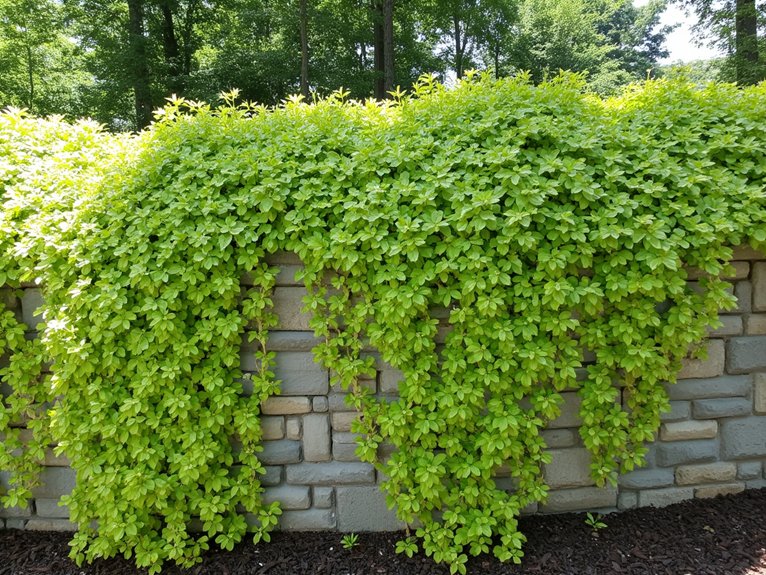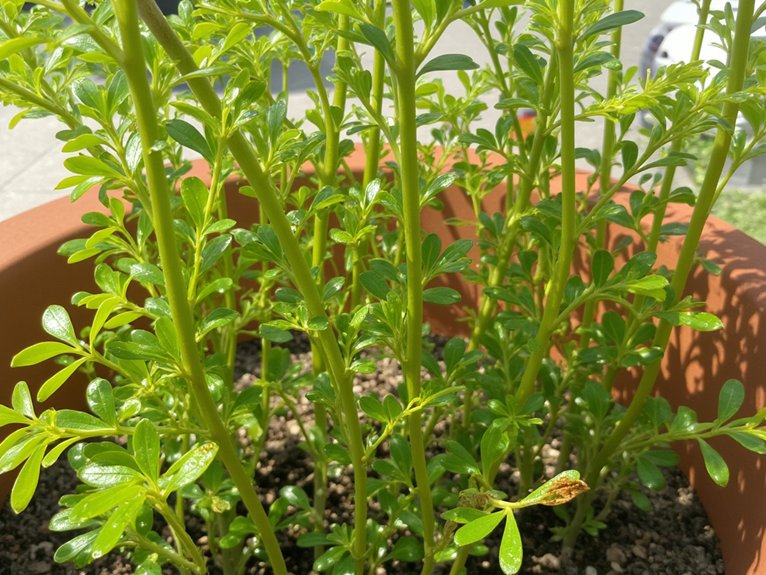If you’re looking to grow Creeping Jenny, you’ll need to master several key aspects of its care to achieve those cascading waves of chartreuse foliage. “The success of Lysimachia nummularia lies in understanding its dual nature – both vigorous and delicate,” notes botanist Dr. Sarah Chen. While this ground cover plant can thrive in various conditions, you’ll discover specific techniques to prevent it from becoming invasive while ensuring its healthy growth throughout the seasons.
Contents
The Perfect Growing Environment for Creeping Jenny

When creating the ideal environment for Creeping Jenny, you’ll want to focus on three key elements: proper lighting, consistent moisture, and rich soil conditions.
For maximum growth, plant your Creeping Jenny in nutrient-rich, well-draining soil that stays consistently moist. While it’s adaptable to various soil types, adding organic matter will enhance its growth. As for light requirements, you can position it in full sun or partial shade – though full sun typically produces the best foliage color, especially in the ‘Aurea’ variety.
Remember to protect the leaves from intense afternoon sun in hot climates to prevent leaf burn.
Essential Propagation and Planting Techniques
Now that you’ve established the perfect growing environment, you’ll find propagating Creeping Jenny remarkably straightforward. You’ve got three reliable methods to choose from:
By Cutting:
- Select healthy stems at least 4 inches long
- Remove lower leaves and place in water or moist soil
- Watch for root development within 2-3 weeks
From Seeds:
- Collect seeds after summer blooming
- Store in paper envelope until spring
- Sow directly in prepared soil
Through Division:
- Dig up established plants in early spring
- Separate into smaller sections with roots attached
- Replant immediately in moist soil
“The key to successful propagation is timing,” notes botanist Dr. Sarah Chen.
Seasonal Care and Maintenance Strategies

Although Creeping Jenny requires minimal maintenance throughout the year, following a seasonal care schedule guarantees your ground cover stays healthy and contained.
For fall maintenance, trim back overgrown stems and remove dead foliage before the first frost. You’ll want to mulch heavily around the plants to protect their roots. “A 2-inch layer of straw or leaves provides excellent winter insulation,” notes botanist Dr. Sarah Chen.
During winter care, remove any snow accumulation that might damage the stems. Check monthly for signs of winter burn and protect exposed areas with additional mulch. By spring, you’ll be ready to divide overgrown sections and apply a balanced fertilizer.
Managing Growth and Preventing Invasive Spread
Since Creeping Jenny’s vigorous growth can quickly overtake garden spaces, implementing effective containment strategies proves essential for responsible cultivation.
For ideal growth control, you’ll want to:
- Install physical barriers 6 inches deep around planting areas
- Trim stems back to 4-6 inches when they extend beyond boundaries
- Remove runners monthly during growing season
- Plant in raised beds or containers to limit spread
For successful landscape integration:
- Space plants 12-18 inches apart
- Remove 1/3 of old growth annually
- Monitor edges where plants meet lawn areas
- Create defined borders using edging materials
Remember to check local regulations, as some regions classify Creeping Jenny as invasive.
Troubleshooting Common Problems and Solutions

While Creeping Jenny is generally a resilient plant, you’ll likely encounter several common problems that can affect its health and appearance. Here’s how to tackle the most frequent issues:
Disease Management:
- If you notice brown spots on leaves, improve air circulation and reduce watering to prevent fungal growth
- Remove affected foliage immediately to stop disease spread
- Apply fungicide in early spring as a preventive measure
Pest Control:
- Check underneath leaves for aphids and remove them with a strong water spray
- Place copper tape around containers to deter slugs and snails
- Apply organic insecticidal soap if pest problems persist
